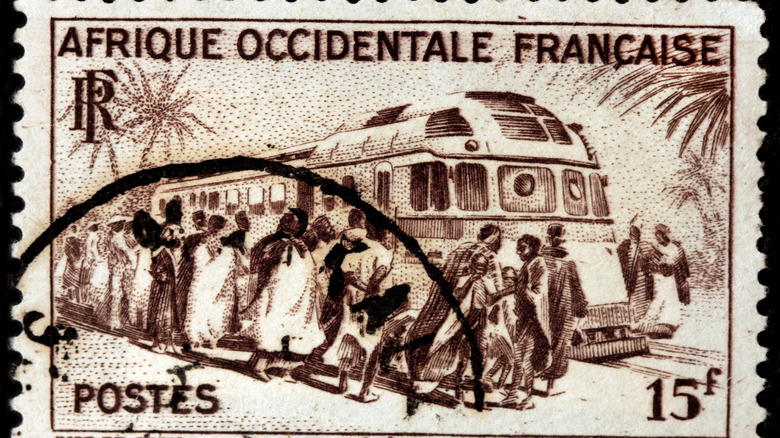This Is How Languages Die
Every two weeks, a language dies. Swarthmore College linguists came to this conclusion in 2007, sounding an alarm bell for many — if not most — of the world's approximately 7,000 languages. Proponents of linguistic diversity have argued that this is a global calamity of epic proportions, as humanity is at risk of losing a wealth of knowledge of the natural world preserved exclusively in languages that live in certain habitats, not to mention lesser-known cultural heritage and opportunities to study how humans process, store, and communicate information.
So how has the world arrived at this point? Language death usually results from a combination of causes over a long period of time, often many centuries. Most often, the circumstances relate to economics and the prestige associated with speaking dominant languages, but sometimes language death is acute, resulting from mass-death events. Today, thanks to cyberspace, languages now face even greater challenges as global heavyweights become ubiquitous lingua francas, or common languages, of global commerce, academia, and diplomacy. Here is how languages die and what could be done to reverse the trend.
The world linguistic situation
Before discussing the process of language death, it is necessary to analyze why there are so many languages going extinct in the first place. Much of this has to do with the world's linguistic situation. According to the University of New Hampshire, there are currently between 6,000 and 7,000 languages spoken worldwide, most of which even educated people have never heard of. Linguists approximate that there have been 31,000 languages in history, most of which were never written down and have left no obvious traces. Most surviving languages today have fewer speakers than the population of Waco, Texas, and around 50% of them have less than 10,000 speakers. As reported by The Guardian, a few number in the single digits.
Thus, it is easy to see why so many languages go extinct — at least from a numbers perspective. While there are many speakers of smaller languages, 96% of the world population — including many speakers of endangered languages — also speak one of the world's dominant tongues, such as English, Mandarin, Hindi, Spanish, and Arabic. These languages also dominate digital and print media, and knowing at least one of them is a must for anyone hoping to achieve economic and social mobility in an increasingly globalized world. This opens the question of who is responsible for killing languages. Are the global heavyweights, combined with past and current colonialism, responsible for trampling languages underfoot? Do speakers of smaller languages share some responsibility? Or is language extinction simply an inevitable numbers game?
Who kills languages?
Before going into how a language dies, there is a major question to answer: Who kills languages? This is a controversial question because it is politically charged in the context of colonialism, globalization, and the dominance of a small handful of languages over the vast majority of others — especially in cyberspace.
In a review, University of Chicago linguist Salikoko Mufwene noted that the party-line theory on language extinction is European colonialism. This theory proposes that the expansion of languages such as English, French, Spanish, and Russian have eradicated non-Western languages around the world. Many of these languages already have smaller bases of speakers and are thus vulnerable to extinction.
But Mufwene rejects this theory as overly simplistic. He notes that most (but not all) languages are killed off by their own speakers, who gradually cease to use the language in any meaningful context. Often, this is spurred by outside circumstances, such as a desire to gain economic advancement that may require knowledge of a national language that, in places such as Africa, is usually French or English. Finally, when languages are constantly borrowing from each other, evolving, and even combining to form new tongues, how exactly can one define that a language has died? Simply put, the question of who's responsible for the death of a language depends on the circumstances, how you define a dead language, and how you distinguish between a dead language and an extinct one.
When does a language die?
So when is a language considered dead, and when is it considered extinct? Per the Linguistic Society of America, a dead language is not spoken organically but survives in other contexts (e.g., Latin in the Catholic Church). An extinct language has no speakers whatsoever. Often, final speakers have imperfect knowledge of the language from lack of practice, language attrition, and the slow infiltration of more dominant languages such as English. An excellent illustration of this phenomenon is Dalmatian, a Romance tongue spoken in modern Croatia that went extinct in 1898.
As John Fisher notes in the Lexical Affiliations of Vegliot, Italian linguist Matteo Bartoli was studying Dalmatian but could not find any native speakers. The best he could do was the partially deaf Antonio (Dalmatian: Tuone) Udaina, who hailed from the Veglia region (today part of Croatia). Udaina learned Dalmatian in childhood alongside a handful of other languages, but had not spoken it in over 20 years. Thus, the samples he gave Bartoli were imperfect and potentially corrupted with loanwords.
Udaina's case shows that when languages finally go extinct, they are already long past revival. Although Dalmatian officially died out after Udaina's death, the language had little chance of being passed on had he lived because he did not remember much. The death of a final speaker simply makes the extinction official, even though the process usually stretches over many centuries and involves numerous factors that, together, cause a language to disappear.
Mass-death language extinction is still possible
While language death is usually gradual, there are a few situations where it occurs rather quickly, particularly in pre-modern eras when plagues and other mass-death events were commonplace. The ancient Sumerian language of Mesopotamia is widely considered the first attested written language. Yet, despite its prominence, it died out relatively quickly. At a meeting of the American Geophysical Union (via livescience), a number of climatologists suggested that droughts and social upheaval ravaged its southern Mesopotamian heartland, resulting in its disappearance.
The climatologists and geologists aligned their findings with archaeological research, which found that between 2200 B.C. and 2000 B.C., the Sumerian lands saw nearly 75% of all settlements abandoned. In a climate of uncertainty and agricultural failure, Semitic-speaking nomads known as Amorites (via "Amorites, Climate Change, and the Negotiation of Identity") gradually established themselves in the region's major cities. These newcomers did not adopt Sumerian, however. Instead, they adopted the Akkadian language, another Semitic tongue related to the language of the Amorites. It seems that surviving Sumerian communities were unable to pass on their language in the face of increasing numbers of Semitic speakers, and it faded away as an everyday, spoken language. Instead, Sumerian became the Latin of Bronze Age Mesopotamia, surviving as a dead language of art, science, and philosophy until the first century B.C.
Elite languages die when their states collapse
There are certain cases of language extinction that happen suddenly, in the context of state collapse. The Hittite language of Anatolia, the oldest-attested Indo-European language, provides such an example. The language suddenly disappeared from the historical record around 1200 B.C., following the collapse of the Hittite Empire and the abandonment of the capital, Hattusas.
The Hittite language's Bronze Age vitality is debated. According to University of Chicago Prof. Theo van den Hout in Visible Language, Hittite was not the empire's demographically dominant language. It served as the medium of Hattusas' elite and of internal administration and diplomacy. Van den Hout argues instead Anatolia's fractured geography allowed Hittite to co-exist with demographically-healthier languages, foremost among them its close relative Luwian.
As time went on, the Luwian-speaking population of the empire increased — even in the Hittite heartland around the capital. According to linguist Ilya Yakubovich, later Hittite texts are increasingly Luwianized, borrowing words, phrases, and grammatical forms into a Hittite language that seems increasingly artificial, spoken by a small elite at official functions. Per van den Hout, Hittite continued as the language of administration and perhaps at court; in everyday conversation, the linguistic changes in texts suggest that Luwian had become the lingua franca. Once the empire and its administration disappeared, the "bottom fell out." Without any administrative system to support or give reason for its existence, Hittite disappeared almost overnight.
Language death through religious persecution
A third example of relatively sudden language death is both modern and tragic. Per The Washington Post, Aramaic — once the lingua franca of the Middle East — survives today as the language of the Middle East's Christians in Turkey, Iraq, and Syria. This was likely Jesus' primary language and is intimately tied to the Chaldean people, who take Aramaic as a mark of identity separating them from their Arabic-speaking Muslim neighbors.
Aramaic is a clear example of language, ethnicity, and religion going hand-in-hand. According to the Institute for Advanced Studies, Aramaic's endangerment today stems from regional instability. Most recently, the Syrian Civil War and its spillover into Iraq has turned tight-knit Aramaic communities into a refugee diaspora in places where Aramaic no longer functions as a daily language. As noted in The Washington Post, Christians in ISIS-controlled territory were not only persecuted; the terror group also destroyed Chaldean history, material heritage, and most importantly churches — the cornerstone of the Aramaic language.
In an interview with The Christian Science Monitor, Aramaic speaker Attalah Shaib argued that Aramaic should be preserved for one simple reason: It was the language of Jesus Christ. Shaib's response suggests that, not only should Aramaic be preserved for its two-millennium association with Syriac Christianity, but that the language can only survive in tandem with the religion. Thus, destroying the speakers was not necessary — ISIS simply targeted the Christian institutions that gave the language a reason to survive.
Destroy the community, destroy the language
The case of Aramaic shows that destroying a language's religious basis can kill the language. But religion often presupposes the existence of community, another key base for the maintenance of language. Thus, emigration and the destruction of a language's homeland can completely eradicate the tongue within a generation — particularly for smaller languages lacking wider utility.
Latvia's Livonian language, related to Finnish, Estonian, and Hungarian, provides a good case study. Per UCL-London scholar Christopher Moseley, Livonian was a language in danger, but still counted on a 1,500-strong base of speakers, many of whom were monolinguals. Thus, it seemed that the language could potentially survive. However, the evisceration of the last Livonian communities during the Second World War, combined with mass emigration, ensured a long and painful death for the language.
According to the Livonian Institute, Livonian met its end in the wake of the 1940 Soviet invasion of the Baltic states. The Livonian homeland became a restricted military zone manned by Russian-speaking Soviet military personnel, who subjected the native Livonians to eviction and restrictions on movement and employment. Some Livonians left their lands and assimilated into the Latvian SSR, whose languages were Latvian and Russian, spurring a revivalist attempt in the 1970s. But Livonian had no chance without its tight-knit community and went extinct in a sea of English far from its homeland. Its last speaker, Grizelda Kristina, left her native fishing community and resettled in Sweden before moving on to Canada, where she — and the Livonian language — died in 2013.
Some languages die thanks to coercion
According to PSU, a nation is a group of people bound together by blood, language, culture, and history, all of which can become vehicles for separatism. Thus dominant cultures may attempt to stamp out rival languages. The Corsican language is a good example. According to Corsica's Italian-language periodical Corsica Oggi, Corsican and its close relative, Italian, were the main languages of the island, even after it fell under French control in 1769. But beginning in the 20th century, France began eradicating Corsican in favor of French, targeting children with coercive measures to that end.
Per Corsican academic Romain Colonna's book "Cuufficialita" ( via Corsica Oggi), the Corsican language seemed healthy in 1915 with a 98% transmission rate from parents to children. In response, the French government began issuing edicts against the language. Pietru Savelli, interviewed in the The Christian Science Monitor, noted that chief among the measures was banning the language from schools and handing down punishment for violators. Under such social pressure, that generation did not pass on the language. Today, the rate of transmission is less than 3%.
The average modern Corsican speaker has a shaky knowledge of the language that is increasingly filled with Gallicisms. Per UNESCO (via CNN), it is considered "definitely endangered." Corsica Oggi has suggested that the language's best chance of survival is increased cultural relations with Italy, while others have allied themselves with other endangered minority language-speakers such as Occitan and Breton in demands for recognition (via France 24).
The most common scenario: gradual switching
While it may be tempting to see language death as the result of persecution, colonialism, or other extraneous factors, the reality is that most languages die as a result of a gradual phenomenon called language shift. In an article published in PNAS, researchers Anne Kandler and James Steele noted that language shift occurs in a host of situations, but most commonly when one language gains greater utility over another.
The underlying shifts are almost always economic. As noted by the University of Florida, many of these minority languages worldwide — particularly in Latin America and Africa — are spoken in poorly developed rural areas or among immigrants. These speakers tend to migrate to large cities for work or education that requires knowledge of the dominant language, such as Spanish or Portuguese in Latin America, French in West Africa, or one of Europe's national languages (e.g., Polish over Kashubian or German over Sorbian).
Minority languages have no obvious utility outside their communities, and very few speakers. As mentioned earlier, most world languages, per the University of New Hampshire, have fewer speakers than the population of Waco, Texas. Thus, unless migrant speakers can create a raison d'etre for their language in the new environment — a tall order given their relatively small numbers — it tends to quickly disappear. And even when communities do successfully establish institutions (e.g., immigrants), assimilation is hard to resist. After all, they don't call New York City the "graveyard of languages" for nothing.
Evolution: When a language dies by changing
Today, Latin is without a doubt a dead language. No one speaks it organically, and it has become fossilized as the liturgical language of the Roman Catholic Church (via Catholic Culture) and the administrative language of Vatican City. But did Latin really ever "die," or did people just start calling it something else?
Language death by evolution hinges upon a phenomenon called diglossia, the practice of using different sociolects in different situations. For example, one will speak formally and correctly in official capacities but will be far more carefree and informal with grammar and pronunciation at a bar with friends. As Western Washington University notes, this is exactly what happened to Latin. According to the Romance language resource Orbilat, Latin, spoken throughout the Roman Empire, existed in numerous dialects collectively called "Vulgar Latin." The elite written standard called "Classical Latin" more or less remained the medieval liturgical and administrative language. Once the Roman Empire collapsed, however, the vernacular dialects diverged to the point of mutual unintelligibility with standard Latin or each other.
Compare the two versions of the Oaths of Strasbourg — one in formal Latin and one in the local ("corrupted") Latin vernacular. The two versions differ considerably — so much so that the vernacular is now considered a separate language called "Old French." But it is impossible to draw a clean break between the two in time because Latin dialects changed gradually over many centuries. Their speakers started calling them "Aragonese," "Romanian," or "Castilian" instead of Latin, eventually crystallizing into today's Romance languages.
The language is unwritten
In the modern world, smaller languages are facing the challenge of global mega-languages such as English, Russian, and Arabic. Such tongues have prestigious bodies of literature and written traditions dating back centuries that give them cultural and political clout. Smaller languages usually lack this history, due to a lack of a written tradition. In many cases they are unwritten, which, according to the University of New Hampshire, puts them at a major disadvantage against more prestigious languages.
As noted in a paper published in Procedia Computer Science, unwritten languages are at greater risk than written ones. An unwritten language can only be passed through person-to-person transmission among native speakers. But as linguist Salikoko Mufwene noted in a BBC interview, speakers tend to lose proficiency to culturally dominant second languages. Since unwritten languages only exists inside their speakers' minds, any forgotten knowledge cannot be recovered. Once a native speaker dies, his linguistic knowledge is likely lost forever. A writing system, however, helps preserve language before it is forgotten while providing a basis for learning material, literature, and more.
A writing system also gives languages an opportunity to spread online. Toppan Digital Language Magazine has noted that the internet is a great place for language preservation, since material is accessible and distributable worldwide rather than on a purely local basis. But without a writing system, an oral language is virtually guaranteed to die in today's globalized world that has increasingly coalesced around English.
Digital extinction
Despite the wealth of possibilities, the internet, as noted in Toppan Digital Language Magazine, has not been kind to language diversity. Twelve languages — chief of all English — account for 98% of the web's language share. English further dominates other media, such as books, academia, and television/movies. This has resulted in the new language phenomenon dubbed "digital extinction."
According to The Guardian, Iceland has been facing this phenomenon due to the island nation's high rates of internet use and English proficiency. Icelandic has a rich history, notably being the closest surviving language to Old Norse (via Medievalists). The language coins new terms instead of borrowing them in an attempt to preserve the language's purity. But the language is not well-represented in the digital world — despite a healthy community of speakers.
Professor Eiríkur Rögnvaldsson and his students have noted that this phenomenon is the result of young Icelanders consuming a steady diet of English-language media. Thus, there is the risk that Icelandic children are not building a base of vocabulary in Icelandic, placing the language's future integrity in doubt. Iceland's government has decided to release open-source software support for Icelandic, since large tech companies are unlikely to provide it given the cost-benefit analysis. But because this phenomenon is so new, it remains to be seen how cyberspace will impact languages outside the major global tongues such as English, Spanish, French, Mandarin, and Arabic.












